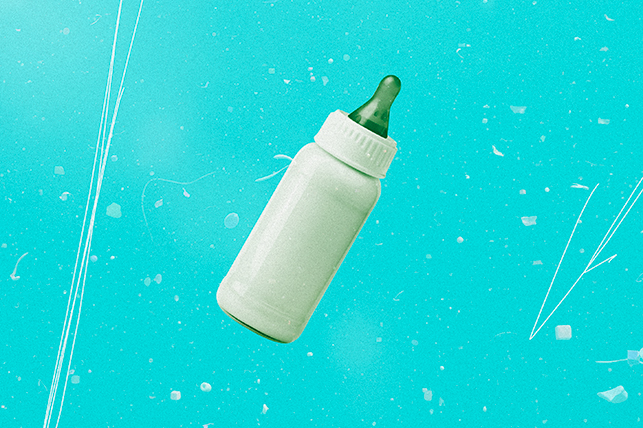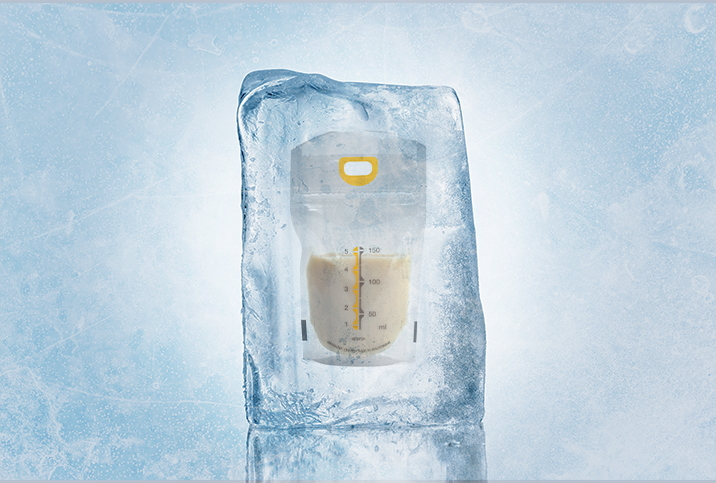Scientists Find Microplastics in Human Breast Milk

Italian researchers have identified microplastics in human breast milk for the first time. It's a finding they say represents a "great concern" for infants who are "extremely vulnerable" to chemical contaminants. The same team, from the Università Politecnica delle Marche (Marche Polytechnic University) in Ancona, Italy, found microplastics in human placentas in 2020.
In a 2022 study published in the journal Polymers, the researchers noted their findings indicate an urgent need for further investigation, better legislation to reduce plastic pollution and efforts to reduce exposure during pregnancy and lactation. They also emphasized that breastfeeding's substantial benefits far exceed any potential disadvantages of contamination.
Inside the study
Researchers took breast milk samples from 34 healthy mothers one week after they had delivered their babies in Rome. Scientists collected, stored and analyzed the milk without the use of plastics and processed control samples to rule out contamination. They found microplastics—defined as plastic particles smaller than 5 millimeters—in 75 percent of the samples. Scientists classified the particles according to shape, color, dimensions and chemical composition to determine their origins.
According to the study authors, the breast milk samples primarily contained plastic compounds made of polyethylene, PVC and polypropylene, all found in packaging. Although smaller particles are likely present, the researchers could not analyze particles smaller than 2 microns. (1,000 microns equal a millimeter.)
Researchers also recorded the parents' consumption of seafood and plastic-packaged foods and drinks and their use of plastic-containing personal hygiene products. They found no correlation between the products people used or consumed and the presence of microplastics in their breast milk. According to the study authors, this confirms plastics' "ubiquitous" nature and the inevitability of human exposure.
Microplastics pervade everything from the ocean floor to mountain peaks and plastic packaging to the air. They also contaminate food and drinking water. A 2019 study published in the journal Environmental Science & Technology suggested that people swallow as many as 50,000 plastic particles yearly. Another 2020 study out of Ireland indicated that bottle-fed babies likely consume millions daily. Other research has identified microplastics in human blood, stools and colectomy samples.
"Microplastics are ubiquitous in the environment. It seems that humans cannot escape them, as they can be inhaled, inadvertently consumed or get through our skin," said Kecia Gaither, M.D., board-certified in OB-GYN and maternal-fetal medicine and director of perinatal services/maternal-fetal medicine at NYC Health + Hospitals/Lincoln in the Bronx in New York City.
How microplastics could impact health
According to the authors of the Italian study, microplastics' impact on humans is still unknown, but several studies have demonstrated a toxic effect on marine wildlife, lab animals and human cell lines. Once internalized, the authors wrote, these particles are not inert, as previously thought, but "likely trigger local or systemic responses."
"The ultimate damage that may occur with microplastics in the body is unknown; more research is needed," Gaither wrote in an email interview.
Theoretically, she explained, microplastics can easily traverse the bloodstream to go anywhere in the body. They are found in placental tissue and can go into cells, so the possibility they can alter cellular function and synthesis and impact normal metabolic functionality in the body—be it adult or fetal—is, in her words, frightening.
"Time will ultimately tell the true story of the impact that microplastics have within the human body," Gaither added.
Despite uncertainty about the effects of microplastic consumption, ample research exists to denote the health implications of various plastic compounds. Microplastics, the study authors wrote, can be vectors for toxins such as phthalates and phenols, including PCBs and PBDEs, which have been established to have adverse effects on human health. Previous research identified these toxins in human breast milk, according to research published by the American Chemical Society.
"It is known that early life stages are the most sensitive to PCBs' toxic effects, which mainly consist of a severe impact on endocrine and cognitive systems, leading to reduced IQ and altered behavior. Similarly, PBDEs are recognized as neurotoxic, especially in children, with effects on motor, cognitive and behavioral development," the Italian study authors wrote. "Phthalates have been reported in the literature to impact male reproductive functionality negatively; moreover, childhood exposure to phthalates was shown to increase the risk of allergic diseases and altered physical/neurocognitive development."
Plastic compounds such as bisphenol A (BPA) and phthalates such as Di(2-ethylhexyl)phthalate (DEHP) are linked to obesity, pubertal abnormalities, premature ovarian insufficiency and polycystic ovary syndrome (PCOS), according to Kyler Elwell Silver, M.D., an OB-GYN in Dallas and an assistant professor at the University of Texas Southwestern Medical Center. All of these conditions are associated with disordered endocrine hormones, including estrogen, testosterone, androgens and thyroid hormones.
"The impacts of these exposures and disruptions in the fetal period, the early infant period and in early childhood have lifelong consequences," Silver wrote in an email interview. "Not only do these exposures have lifelong consequences for the exposed individual, but they also cause epigenetic mutations that alter the gene expression for subsequent generations."
Although some of the more notorious plastic chemicals haven't been used in manufacturing and production for years, they remain a permanent fixture in the environment. Known as "forever chemicals," they don't degrade like natural compounds. They persist in the soil, air, water and bodies of people, animals and fish to be unendingly consumed and recycled.
Why breast milk is still best
Breast milk remains the optimal food source for human babies for several reasons, according to the study's authors and other experts.
"Breast milk has the specific nutritional and energy requirements for human infants. It also has a large concentration of maternal antibodies to common human diseases and offers disease protection to an infant prior to their vaccinations," Silver said.
Breastfed infants, she continued, experience a lower risk of conditions such as childhood obesity, asthma, sudden infant death syndrome (SIDS) and gastrointestinal infections. Breastfeeding also decreases their risk of diabetes later in life. She pointed out that for the first six months of life, the American Academy of Pediatrics and the World Health Organization recommend exclusive breastfeeding.
Feeding directly at the breast is also beneficial because it promotes bonding, said Beth Ann Martin, M.P.H., a certified postpartum doula and lactation education counselor at LaVie Mom, based in Greensboro, North Carolina. Mothers can benefit, too, as breastfeeding can decrease the risk of ovarian and breast cancer, hypertension and type 2 diabetes, according to Martin, Gaither and Silver.
How to reduce contamination
"Unfortunately, plastics and microplastics are ubiquitous contaminants in the human ecosystem," Silver said. "Eliminating exposure to mom, fetus and newborn is unrealistic. In general, we should all be working to eliminate single-use plastics in our daily lives: water bottles, plastic food containers, plastic bottles of cleaning products, etcetera. Specifically, concerned mothers should consider glass bottles for their newborns, glass food-storage containers for their own foods, and limit heating of food [and] beverages in plastic containers."
Heating breast milk or formula, in particular, should only be done in glass containers, Silver added. Heat weakens chemical bonds in plastic products, increasing the likelihood of compounds infiltrating the container's contents.
The Italian researchers echoed this sentiment, adding that people who are pregnant or nursing should avoid or limit exposure to cosmetics and hygiene products containing microplastics and clothing made of synthetic fabrics, such as polyester and acrylic.
According to research by the Plastic Soup Foundation, an environmental nonprofit group based in the Netherlands, 87 percent of products from the top cosmetics brands contain microplastics. Conspicuous examples include glitter and face and body washes with microbeads, although various items, including mascara, lipstick and foundation, can also contain plastics.
If glass is too expensive, steel baby bottles, silicone or rubber nipples, and silicone storage bags are practical alternatives, according to Martin.
"The number one goal should always be to have a well-fed baby, whether breastfeeding, formula feeding, plastic or glass bottle-fed," Silver stressed.


















